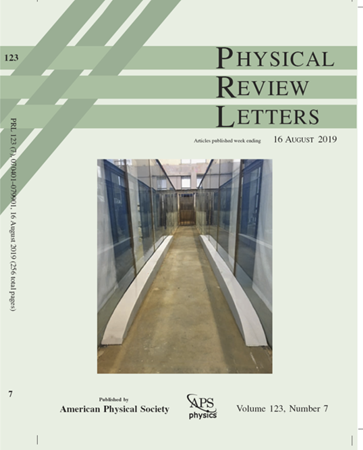Cooling the Shock: New Supernova Constraints on Dark Photons
IF 8.1
1区 物理与天体物理
Q1 PHYSICS, MULTIDISCIPLINARY
引用次数: 0
Abstract
During the accretion phase of a core-collapse supernova (SN), dark-photon (DP) cooling can be largest in the gain layer below the stalled shock wave. In this way, it could counteract the usual shock rejuvenation by neutrino energy deposition and thus prevent the explosion. This peculiar energy-loss profile derives from the resonant nature of DP production. The largest cooling and thus strongest constraints obtain for DP masses of 0.1–0.4 MeV, a range corresponding to the photon plasma mass in the gain region. Electron-capture supernovae, once observationally unambiguously identified, could provide strong bounds even down to nearly 0.01 MeV. For a coupling strength so small that neutrino-driven explosions are expected to survive, the DP cooling of the core is too small to modify the neutrino signal, i.e., our new argument supersedes the traditional SN1987A cooling bound.冷却冲击:新超新星对暗光子的约束
在核心坍缩超新星(SN)的吸积阶段,暗光子(DP)冷却在停滞激波下方的增益层中最大。这样就可以抵消通常的中微子能量沉积的冲击返老还老,从而防止爆炸。这种特殊的能量损失分布源于DP生产的谐振性质。在DP质量为0.1-0.4 MeV时,得到了最大的冷却和最强的约束,这一范围对应于光子等离子体在增益区域的质量。电子捕获超新星,一旦在观测上被明确地识别出来,甚至可以提供低至接近0.01兆电子伏特的强边界。对于耦合强度如此之小,以至于中微子驱动的爆炸预计会存活下来,核心的DP冷却太小,无法改变中微子信号,也就是说,我们的新论点取代了传统的SN1987A冷却界限。2025年由美国物理学会出版
本文章由计算机程序翻译,如有差异,请以英文原文为准。
求助全文
约1分钟内获得全文
求助全文
来源期刊

Physical review letters
物理-物理:综合
CiteScore
16.50
自引率
7.00%
发文量
2673
审稿时长
2.2 months
期刊介绍:
Physical review letters(PRL)covers the full range of applied, fundamental, and interdisciplinary physics research topics:
General physics, including statistical and quantum mechanics and quantum information
Gravitation, astrophysics, and cosmology
Elementary particles and fields
Nuclear physics
Atomic, molecular, and optical physics
Nonlinear dynamics, fluid dynamics, and classical optics
Plasma and beam physics
Condensed matter and materials physics
Polymers, soft matter, biological, climate and interdisciplinary physics, including networks
 求助内容:
求助内容: 应助结果提醒方式:
应助结果提醒方式:


